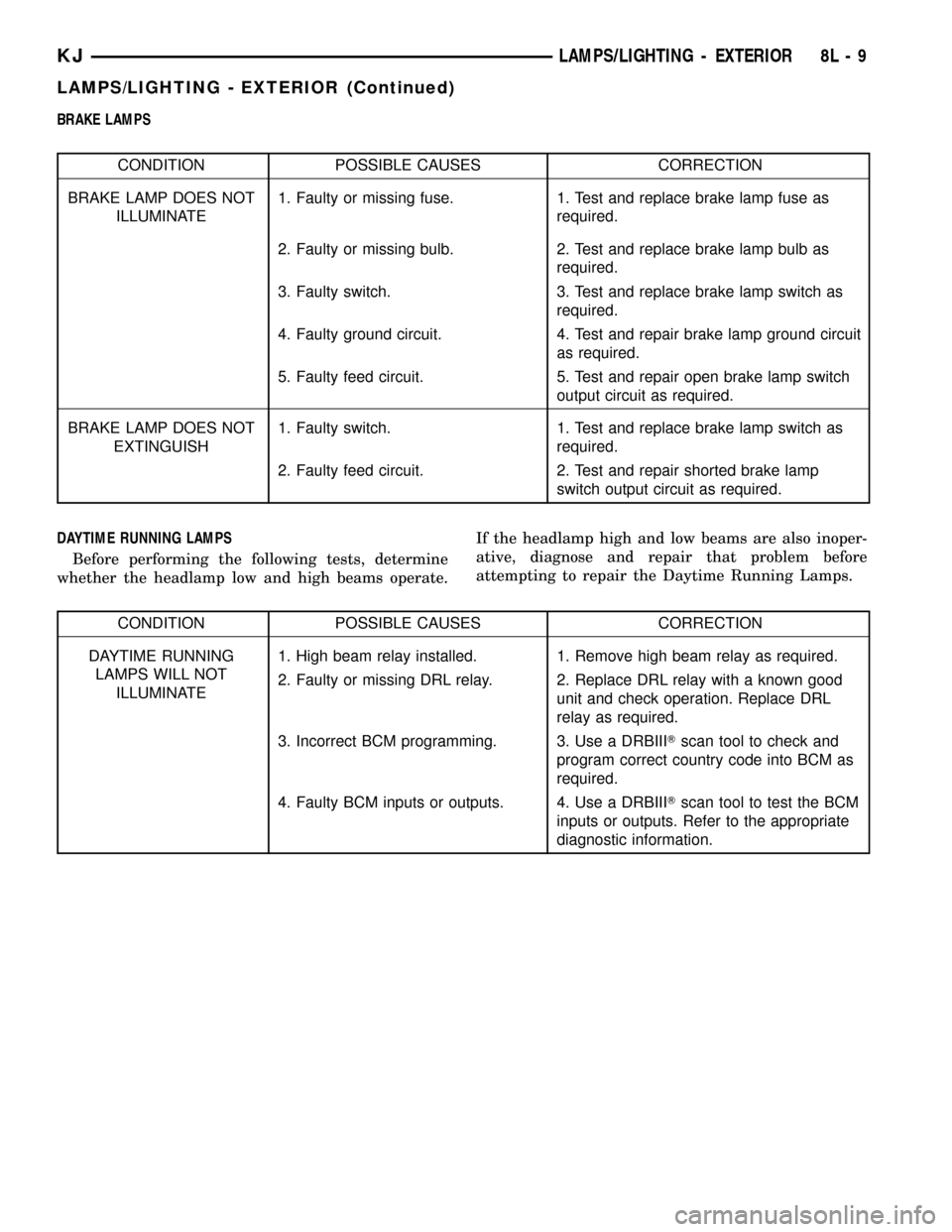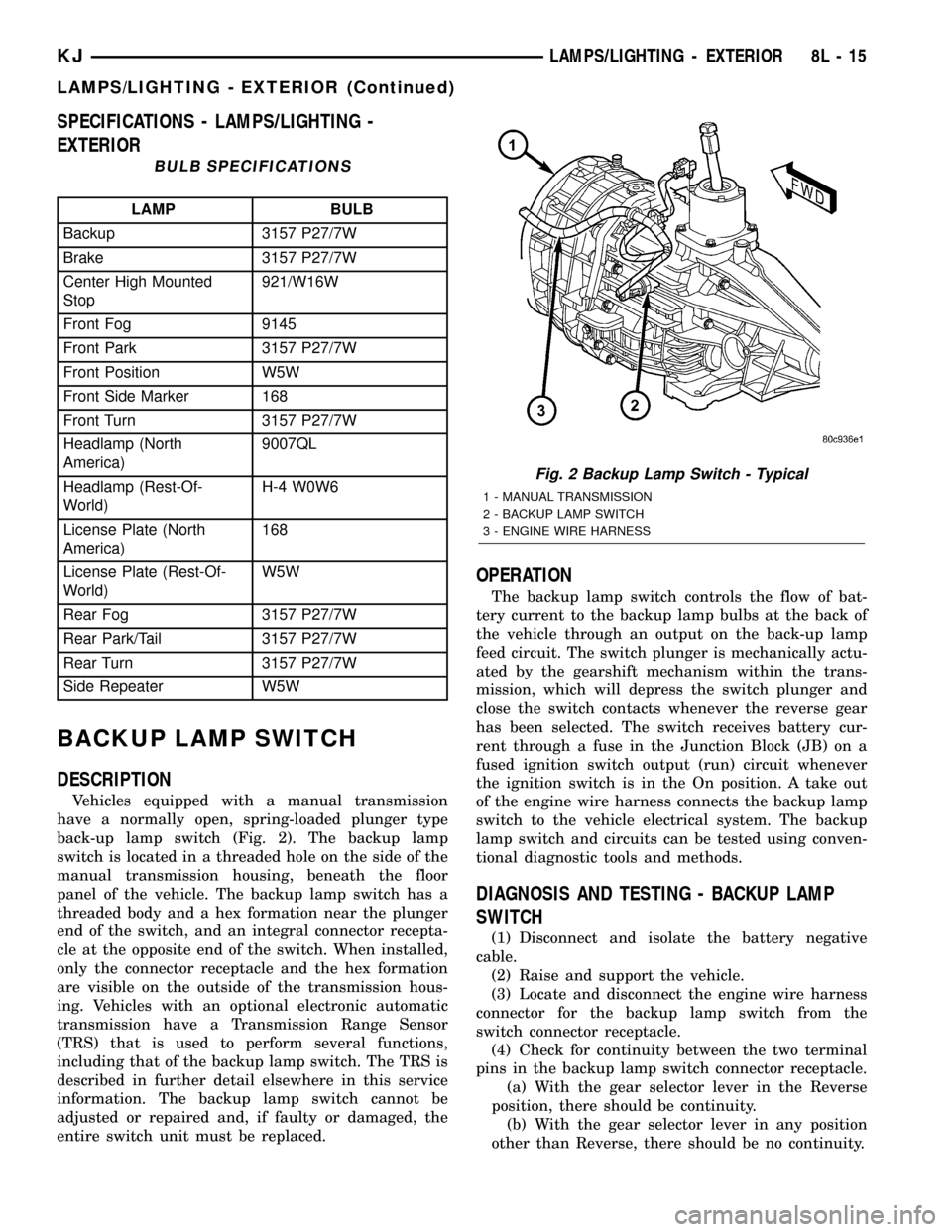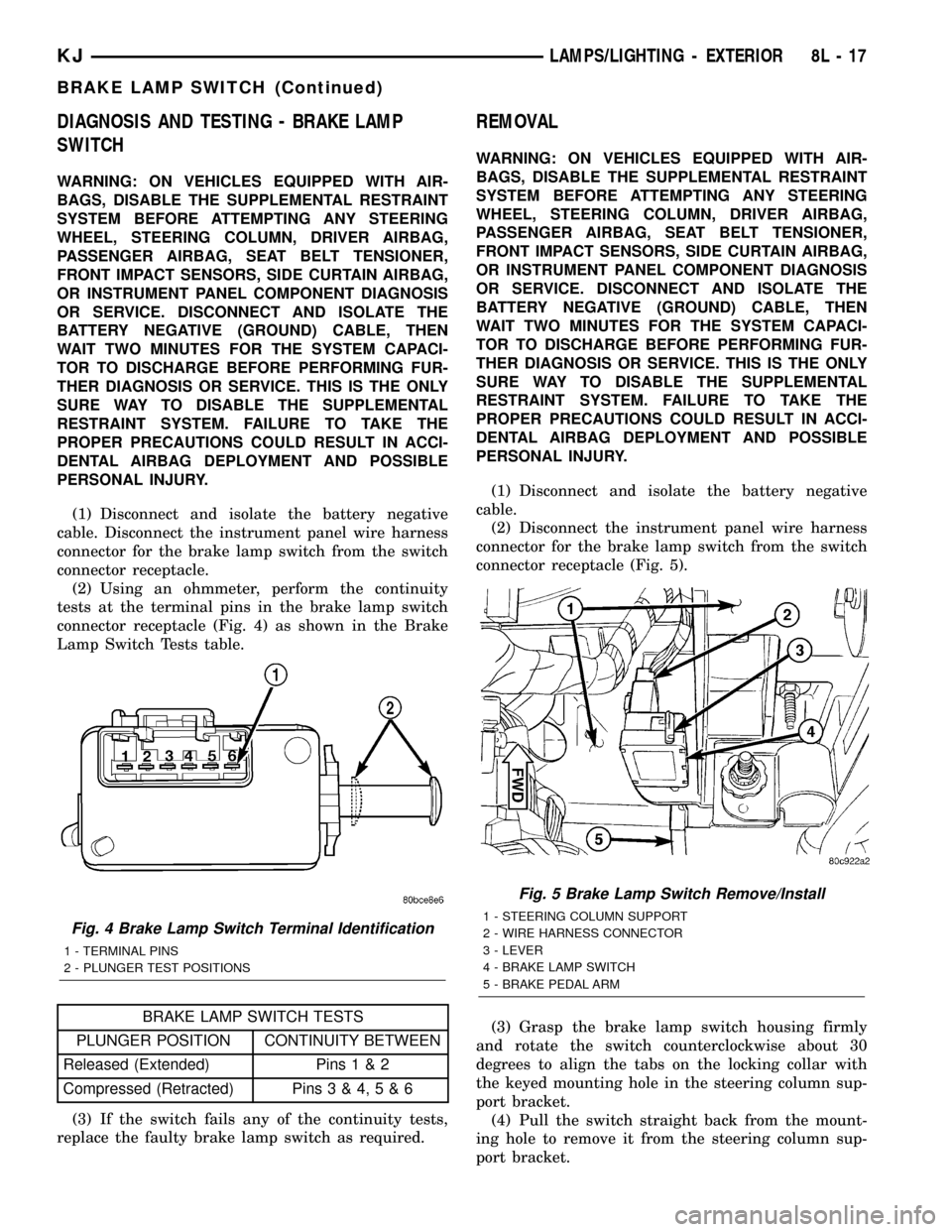Brake lamp switch JEEP LIBERTY 2002 KJ / 1.G Owner's Manual
[x] Cancel search | Manufacturer: JEEP, Model Year: 2002, Model line: LIBERTY, Model: JEEP LIBERTY 2002 KJ / 1.GPages: 1803, PDF Size: 62.3 MB
Page 445 of 1803

front of the vehicle. In certain markets where
required, a headlamp leveling actuator motor is
included on each headlamp.
²Park Lamps- The park lamps include the front
park lamps and front side marker lamps that are
integral to the front lamp units mounted at each end
of the bumper fascia at the front of the vehicle, as
well as the rear park lamps and rear side marker
lamps that are integral to the rear lamp units
mounted to the back of the quarter panel on each
side of the tailgate at the rear of the vehicle. The
park lamps include a license plate lamp or lamps,
depending upon the requirements of the market for
which the vehicle is manufactured. Vehicles with a
license plate tub located near the left end of the rear
bumper fascia have a single lamp, while vehicles
with a license plate module located on the spare tire
carrier have two license plate lamps. In certain mar-
kets where required, a front position lamp that is
integral to each headlamp unit is illuminated instead
of the front park lamps and front side marker lamps
in the park lamps circuit; and, a rectangular, red
reflector is located on the rear bumper fascia just
inboard and below each rear lamp unit.
²Rear Fog Lamps- Rear fog lamps are avail-
able only in certain markets where they are required
equipment. The rear fog lamps are integral to the
rear lamp units mounted to the back of the quarter
panel on each side of the tailgate at the rear of the
vehicle.
²Turn Signal Lamps- The turn signal lamps
include the front turn signal and front side marker
lamps that are integral to the front lamp units
mounted at each end of the bumper fascia at the
front of the vehicle, as well as rear turn signal lamps
that are integral to the rear lamp units mounted to
the back of the quarter panel on each side of the tail-
gate at the rear of the vehicle. In certain markets
where required, a repeater lamp unit mounted to
each front fender just behind the front wheel opening
is illuminated instead of the front side marker lamp
in each turn signal lamp circuit.
Other components of the exterior lighting system
for this model include:
²Combination Flasher- An electronic combina-
tion flasher is integral to the hazard warning switch
in the center of the instrument panel.
²Backup Lamp Switch- Vehicles equipped with
a manual transmission have a plunger-type backup
lamp switch located on the transmission housing. ATransmission Range Sensor (TRS) integral to the
solenoid pack on the valve body of the optional elec-
tronic automatic transmission performs the backup
lamp switch function on models that are so equipped.
²Brake Lamp Switch- A plunger-type brake
lamp switch is located on the steering column sup-
port bracket under the instrument panel and actu-
ated by the brake pedal arm.
²Body Control Module- The Body Control
Module (BCM) is located on the Junction Block (JB)
under the driver side outboard end of the instrument
panel. (Refer to 8 - ELECTRICAL/ELECTRONIC
CONTROL MODULES/BODY CONTROL MODULE
- DESCRIPTION).
²Daytime Running Lamp Relay- Vehicles
manufactured for sale in Canada use a solid state
Daytime Running Lamps (DRL) relay installed in the
Junction Block (JB) instead of the conventional high
beam relay.
²Front Fog Lamp Relay- Vehicles equipped
with the optional front fog lamps have a front fog
lamp relay located in the Junction Block (JB).
²Hazard Switch- The hazard switch is located
near the center of the instrument panel and includes
the integral electronic combination flasher circuitry
for the hazard warning system and the turn signal
system.
²Headlamp Leveling Motor- A headlamp lev-
eling actuator motor is located on the back of each
headlamp housing of vehicles manufactured for cer-
tain markets where this equipment is required.
²Headlamp Leveling Switch- A thumbwheel
actuated headlamp leveling switch is mounted in the
driver side inboard instrument panel trim bezel of
vehicles manufactured for certain markets where this
equipment is required.
²High Beam Relay- A high beam relay is
located in the Junction Block (JB) of all vehicles
except those that are manufactured for sale in Can-
ada. Canadian vehicles have a solid state Daytime
Running Lamps (DRL) relay in the JB instead of the
high beam relay.
²Low Beam Relay- A low beam relay is located
in the Junction Block (JB) of all vehicles.
²Multi-Function Switch- The multi-function
switch is located on the top of the steering column,
just below the steering wheel. The multi-function
switch includes a left (lighting) control stalk and a
right (wiper) control stalk. The left control stalk is
dedicated to providing almost all of the driver con-
1 - HEADLAMP UNIT (2)
2 - REPEATER LAMP UNIT (2)
3 - FRONT POSITION LAMP (2)
4 - FRONT LAMP UNIT (2)
5 - FRONT FOG LAMP (2)6 - CENTER HIGH MOUNTED STOP LAMP UNIT
7 - REAR LAMP UNIT
8 - LICENSE PLATE LAMP UNIT
8L - 4 LAMPS/LIGHTING - EXTERIORKJ
LAMPS/LIGHTING - EXTERIOR (Continued)
Page 446 of 1803

trols for both the exterior and interior lighting sys-
tems.
²Park Lamp Relay- A park lamp relay is
located in the Junction Block (JB) of all vehicles.
²Rear Fog Lamp Relay- Vehicles manufac-
tured for certain markets where rear fog lamps are
required equipment have a rear fog lamp relay
located in the Junction Block (JB).
²Trailer Tow Adapter- Vehicles equipped with
a factory-installed trailer towing package have an
adapter provided that adapts the factory-installed
heavy duty 7-way trailer tow connector to a conven-
tional 4-way light duty connector.
²Trailer Tow Connector- Vehicles equipped
with a factory-installed trailer towing package have a
heavy duty 7-way trailer tow connector installed in a
bracket on the trailer hitch receiver.
²Trailer Tow Relays- Vehicles equipped with a
factory-installed trailer towing package have a con-
nector bank containing four relays located behind the
right quarter trim panel and over the right rear
wheel housing. The four relays are used to supply
fused ignition switch output (run), brake lamps, right
turn signal, and left turn signal outputs to a trailer
through the trailer tow wiring and connectors.
Hard wired circuitry connects the exterior lighting
system components to the electrical system of the
vehicle. These hard wired circuits are integral to sev-
eral wire harnesses, which are routed throughout the
vehicle and retained by many different methods.
These circuits may be connected to each other, to the
vehicle electrical system and to the exterior lighting
system components through the use of a combination
of soldered splices, splice block connectors, and many
different types of wire harness terminal connectors
and insulators. Refer to the appropriate wiring infor-
mation. The wiring information includes wiring dia-
grams, proper wire and connector repair procedures,
further details on wire harness routing and reten-
tion, as well as pin-out and location views for the
various wire harness connectors, splices and grounds.
OPERATION
Following are paragraphs that briefly describe the
operation of each of the major exterior lighting sys-
tems. The hard wired circuits and components of the
exterior lighting systems may be diagnosed and
tested using conventional diagnostic tools and proce-
dures. However, conventional diagnostic methods
may not prove conclusive in the diagnosis of the Body
Control Module (BCM), the ElectroMechanical
Instrument Cluster (EMIC), the Powertrain Control
Module (PCM), or the Programmable Communica-
tions Interface (PCI) data bus network. The most
reliable, efficient, and accurate means to diagnose
the BCM, the EMIC, the PCM, and the PCI data busnetwork inputs and outputs related to the various
exterior lighting systems requires the use of a
DRBIIItscan tool. Refer to the appropriate diagnos-
tic information.
BACKUP LAMPS
The backup (or reverse) lamps have a path to
ground at all times through their connection to the
rear lighting wire harness from a take out of the rear
body wire harness with an eyelet terminal connector
that is secured by a ground screw to the base of the
right D-pillar behind the quarter trim panel. The
backup lamps receive battery current from a fused
ignition switch output (run) fuse in the Junction
Block (JB) on the back-up lamp feed circuit only
when the backup lamp switch (manual transmission),
or backup lamp switch circuit of the Transmission
Range Sensor (TRS - electronic automatic transmis-
sion) is closed by the gearshift mechanism within the
transmission.
BRAKE LAMPS
The brake (or stop) lamps have a path to ground at
all times through their connection to the rear light-
ing wire harness from a take out of the rear body
wire harness with an eyelet terminal connector that
is secured by a screw to the base of the right D-pillar
behind the quarter trim panel. The Center High
Mounted Stop Lamp (CHMSL) has a path to ground
at all times through its connection to the rear body
wire harness from a take out of the rear body wire
harness with an eyelet terminal connector that is
secured by a ground screw to the driver side D-pillar
(left side D-pillar for left-hand drive, right side D-pil-
lar for right-hand drive) behind the quarter trim
panel. The brake lamps and CHMSL receive battery
current from a fused B(+) fuse in the Junction Block
(JB) on the brake lamp switch output circuit only
when the brake lamp switch circuit of the brake
lamp switch is closed by the brake pedal arm.
DAYTIME RUNNING LAMPS
Vehicles manufactured for sale in Canada illumi-
nate the high beam filament at a reduced intensity
when the engine is running and the exterior lamps
are turned off. This feature is enabled by the Body
Control Module (BCM) and a solid state Daytime
Running Lamps (DRL) relay, which is installed in the
Junction Block (JB) and the high beam relay is omit-
ted. When the BCM monitors an engine speed signal
of greater than 450 RPM and the status of the exte-
rior lighting switch input from the multi-function
switch is Off, the BCM duty cycles the DRL relay to
produce illumination of the headlamp high beam fil-
aments at a reduced intensity. The BCM also pro-
vides normal headlamp high beam operation through
the DRL relay on vehicles so equipped. When the
KJLAMPS/LIGHTING - EXTERIOR 8L - 5
LAMPS/LIGHTING - EXTERIOR (Continued)
Page 450 of 1803

BRAKE LAMPS
CONDITION POSSIBLE CAUSES CORRECTION
BRAKE LAMP DOES NOT
ILLUMINATE1. Faulty or missing fuse. 1. Test and replace brake lamp fuse as
required.
2. Faulty or missing bulb. 2. Test and replace brake lamp bulb as
required.
3. Faulty switch. 3. Test and replace brake lamp switch as
required.
4. Faulty ground circuit. 4. Test and repair brake lamp ground circuit
as required.
5. Faulty feed circuit. 5. Test and repair open brake lamp switch
output circuit as required.
BRAKE LAMP DOES NOT
EXTINGUISH1. Faulty switch. 1. Test and replace brake lamp switch as
required.
2. Faulty feed circuit. 2. Test and repair shorted brake lamp
switch output circuit as required.
DAYTIME RUNNING LAMPS
Before performing the following tests, determine
whether the headlamp low and high beams operate.If the headlamp high and low beams are also inoper-
ative, diagnose and repair that problem before
attempting to repair the Daytime Running Lamps.
CONDITION POSSIBLE CAUSES CORRECTION
DAYTIME RUNNING
LAMPS WILL NOT
ILLUMINATE1. High beam relay installed. 1. Remove high beam relay as required.
2. Faulty or missing DRL relay. 2. Replace DRL relay with a known good
unit and check operation. Replace DRL
relay as required.
3. Incorrect BCM programming. 3. Use a DRBIIITscan tool to check and
program correct country code into BCM as
required.
4. Faulty BCM inputs or outputs. 4. Use a DRBIIITscan tool to test the BCM
inputs or outputs. Refer to the appropriate
diagnostic information.
KJLAMPS/LIGHTING - EXTERIOR 8L - 9
LAMPS/LIGHTING - EXTERIOR (Continued)
Page 456 of 1803

SPECIFICATIONS - LAMPS/LIGHTING -
EXTERIOR
BULB SPECIFICATIONS
LAMP BULB
Backup 3157 P27/7W
Brake 3157 P27/7W
Center High Mounted
Stop921/W16W
Front Fog 9145
Front Park 3157 P27/7W
Front Position W5W
Front Side Marker 168
Front Turn 3157 P27/7W
Headlamp (North
America)9007QL
Headlamp (Rest-Of-
World)H-4 W0W6
License Plate (North
America)168
License Plate (Rest-Of-
World)W5W
Rear Fog 3157 P27/7W
Rear Park/Tail 3157 P27/7W
Rear Turn 3157 P27/7W
Side Repeater W5W
BACKUP LAMP SWITCH
DESCRIPTION
Vehicles equipped with a manual transmission
have a normally open, spring-loaded plunger type
back-up lamp switch (Fig. 2). The backup lamp
switch is located in a threaded hole on the side of the
manual transmission housing, beneath the floor
panel of the vehicle. The backup lamp switch has a
threaded body and a hex formation near the plunger
end of the switch, and an integral connector recepta-
cle at the opposite end of the switch. When installed,
only the connector receptacle and the hex formation
are visible on the outside of the transmission hous-
ing. Vehicles with an optional electronic automatic
transmission have a Transmission Range Sensor
(TRS) that is used to perform several functions,
including that of the backup lamp switch. The TRS is
described in further detail elsewhere in this service
information. The backup lamp switch cannot be
adjusted or repaired and, if faulty or damaged, the
entire switch unit must be replaced.
OPERATION
The backup lamp switch controls the flow of bat-
tery current to the backup lamp bulbs at the back of
the vehicle through an output on the back-up lamp
feed circuit. The switch plunger is mechanically actu-
ated by the gearshift mechanism within the trans-
mission, which will depress the switch plunger and
close the switch contacts whenever the reverse gear
has been selected. The switch receives battery cur-
rent through a fuse in the Junction Block (JB) on a
fused ignition switch output (run) circuit whenever
the ignition switch is in the On position. A take out
of the engine wire harness connects the backup lamp
switch to the vehicle electrical system. The backup
lamp switch and circuits can be tested using conven-
tional diagnostic tools and methods.
DIAGNOSIS AND TESTING - BACKUP LAMP
SWITCH
(1) Disconnect and isolate the battery negative
cable.
(2) Raise and support the vehicle.
(3) Locate and disconnect the engine wire harness
connector for the backup lamp switch from the
switch connector receptacle.
(4) Check for continuity between the two terminal
pins in the backup lamp switch connector receptacle.
(a) With the gear selector lever in the Reverse
position, there should be continuity.
(b) With the gear selector lever in any position
other than Reverse, there should be no continuity.
Fig. 2 Backup Lamp Switch - Typical
1 - MANUAL TRANSMISSION
2 - BACKUP LAMP SWITCH
3 - ENGINE WIRE HARNESS
KJLAMPS/LIGHTING - EXTERIOR 8L - 15
LAMPS/LIGHTING - EXTERIOR (Continued)
Page 457 of 1803

BRAKE LAMP SWITCH
DESCRIPTION
The brake lamp switch is a three circuit, spring-
loaded plunger actuated switch that is secured to the
steering column support bracket under the driver
side of the instrument panel (Fig. 3). The brake lamp
switch is contained within a rectangular molded plas-
tic housing with an integral connector receptacle fea-
turing six terminal pins and a red plastic Connector
Position Assurance (CPA) lock. The switch is con-
nected to the vehicle electrical system through a ded-
icated take out and connector of the instrument
panel wire harness. The switch plunger extends
through a mounting collar on one end of the switch
housing. The plunger has a one time telescoping self-
adjustment feature that is achieved after the switch
is installed by moving an adjustment release lever on
the opposite end of the switch housing clockwise,
until it locks in a position that is parallel to the con-
nector receptacle. The brake lamp switch self-adjust-
ment is a one time feature. Once the feature has
been used, the switch cannot be readjusted. A ªDO
NOT RE-INSTALLº warning is molded into the
switch housing below the connector receptacle.
An installed brake lamp switch cannot be read-
justed or repaired. If the switch is damaged, faulty,
or removed from its mounting position for any rea-
son, it must be replaced with a new unit.
OPERATION
The brake lamp switch controls three different cir-
cuits, one normally open and two normally closed.
These circuits are described as follows:
²Brake Lamp Switch Circuit- A normally
open brake lamp switch circuit receives battery cur-
rent on a fused B(+) circuit from a fuse in the Junc-
tion Block (JB), and supplies battery current to the
brake lamps and the Controller Antilock Brake
(CAB) on a brake lamp switch output circuit when
the brake pedal is depressed (brake lamp switch
plunger released).
²Brake Lamp Switch Signal Circuit- A nor-
mally closed brake lamp switch signal circuit receives
a path to ground through a splice block located in the
instrument panel wire harness with an eyelet termi-
nal connector that is secured by a nut to a ground
stud on the driver side instrument panel end bracket
near the Junction Block (JB). This circuit supplies a
ground input to the Powertrain Control Module
(PCM) on a brake lamp switch sense circuit when the
brake pedal is released (brake lamp switch plunger is
depressed).
²Speed Control Circuit- A normally closed
speed control circuit receives battery current from
the Powertrain Control Module on a speed control
supply circuit, and supplies battery current to the
speed control servo solenoids (dump, vacuum, and
vent) on a speed control brake switch output circuit
when the speed control system is turned on and the
brake pedal is released (brake lamp switch plunger is
depressed).
Concealed within the brake lamp switch housing
the components of the self-adjusting brake switch
plunger consist of a two-piece telescoping plunger, a
split plunger locking collar, and a release wedge. The
release lever has an integral shaft with a wedge that
spreads the plunger locking collar to an open or
released position. After the switch is installed and
the brake pedal is released, the plunger telescopes to
the correct adjustment position. When the release
lever is moved to the release position, the wedge is
disengaged from the locking collar causing the collar
to apply a clamping pressure to the two plunger
halves fixing the plunger length.
The brake lamp switch can be diagnosed using con-
ventional diagnostic tools and methods.
Fig. 3 Brake Lamp Switch
1 - CONNECTOR RECEPTACLE
2 - BRAKE LAMP SWITCH
3 - PLUNGER
4 - COLLAR
5 - LEVER
8L - 16 LAMPS/LIGHTING - EXTERIORKJ
Page 458 of 1803

DIAGNOSIS AND TESTING - BRAKE LAMP
SWITCH
WARNING: ON VEHICLES EQUIPPED WITH AIR-
BAGS, DISABLE THE SUPPLEMENTAL RESTRAINT
SYSTEM BEFORE ATTEMPTING ANY STEERING
WHEEL, STEERING COLUMN, DRIVER AIRBAG,
PASSENGER AIRBAG, SEAT BELT TENSIONER,
FRONT IMPACT SENSORS, SIDE CURTAIN AIRBAG,
OR INSTRUMENT PANEL COMPONENT DIAGNOSIS
OR SERVICE. DISCONNECT AND ISOLATE THE
BATTERY NEGATIVE (GROUND) CABLE, THEN
WAIT TWO MINUTES FOR THE SYSTEM CAPACI-
TOR TO DISCHARGE BEFORE PERFORMING FUR-
THER DIAGNOSIS OR SERVICE. THIS IS THE ONLY
SURE WAY TO DISABLE THE SUPPLEMENTAL
RESTRAINT SYSTEM. FAILURE TO TAKE THE
PROPER PRECAUTIONS COULD RESULT IN ACCI-
DENTAL AIRBAG DEPLOYMENT AND POSSIBLE
PERSONAL INJURY.
(1) Disconnect and isolate the battery negative
cable. Disconnect the instrument panel wire harness
connector for the brake lamp switch from the switch
connector receptacle.
(2) Using an ohmmeter, perform the continuity
tests at the terminal pins in the brake lamp switch
connector receptacle (Fig. 4) as shown in the Brake
Lamp Switch Tests table.
BRAKE LAMP SWITCH TESTS
PLUNGER POSITION CONTINUITY BETWEEN
Released (Extended) Pins1&2
Compressed (Retracted) Pins3&4,5&6
(3) If the switch fails any of the continuity tests,
replace the faulty brake lamp switch as required.
REMOVAL
WARNING: ON VEHICLES EQUIPPED WITH AIR-
BAGS, DISABLE THE SUPPLEMENTAL RESTRAINT
SYSTEM BEFORE ATTEMPTING ANY STEERING
WHEEL, STEERING COLUMN, DRIVER AIRBAG,
PASSENGER AIRBAG, SEAT BELT TENSIONER,
FRONT IMPACT SENSORS, SIDE CURTAIN AIRBAG,
OR INSTRUMENT PANEL COMPONENT DIAGNOSIS
OR SERVICE. DISCONNECT AND ISOLATE THE
BATTERY NEGATIVE (GROUND) CABLE, THEN
WAIT TWO MINUTES FOR THE SYSTEM CAPACI-
TOR TO DISCHARGE BEFORE PERFORMING FUR-
THER DIAGNOSIS OR SERVICE. THIS IS THE ONLY
SURE WAY TO DISABLE THE SUPPLEMENTAL
RESTRAINT SYSTEM. FAILURE TO TAKE THE
PROPER PRECAUTIONS COULD RESULT IN ACCI-
DENTAL AIRBAG DEPLOYMENT AND POSSIBLE
PERSONAL INJURY.
(1) Disconnect and isolate the battery negative
cable.
(2) Disconnect the instrument panel wire harness
connector for the brake lamp switch from the switch
connector receptacle (Fig. 5).
(3) Grasp the brake lamp switch housing firmly
and rotate the switch counterclockwise about 30
degrees to align the tabs on the locking collar with
the keyed mounting hole in the steering column sup-
port bracket.
(4) Pull the switch straight back from the mount-
ing hole to remove it from the steering column sup-
port bracket.
Fig. 4 Brake Lamp Switch Terminal Identification
1 - TERMINAL PINS
2 - PLUNGER TEST POSITIONS
Fig. 5 Brake Lamp Switch Remove/Install
1 - STEERING COLUMN SUPPORT
2 - WIRE HARNESS CONNECTOR
3 - LEVER
4 - BRAKE LAMP SWITCH
5 - BRAKE PEDAL ARM
KJLAMPS/LIGHTING - EXTERIOR 8L - 17
BRAKE LAMP SWITCH (Continued)
Page 459 of 1803

(5) Discard the removed brake lamp switch.
CAUTION: Always replace a removed brake lamp
switch with a new unit. This is a one time compo-
nent and is not intended for reinstallation.
INSTALLATION
WARNING: ON VEHICLES EQUIPPED WITH AIR-
BAGS, DISABLE THE SUPPLEMENTAL RESTRAINT
SYSTEM BEFORE ATTEMPTING ANY STEERING
WHEEL, STEERING COLUMN, DRIVER AIRBAG,
PASSENGER AIRBAG, SEAT BELT TENSIONER,
FRONT IMPACT SENSORS, SIDE CURTAIN AIRBAG,
OR INSTRUMENT PANEL COMPONENT DIAGNOSIS
OR SERVICE. DISCONNECT AND ISOLATE THE
BATTERY NEGATIVE (GROUND) CABLE, THEN
WAIT TWO MINUTES FOR THE SYSTEM CAPACI-
TOR TO DISCHARGE BEFORE PERFORMING FUR-
THER DIAGNOSIS OR SERVICE. THIS IS THE ONLY
SURE WAY TO DISABLE THE SUPPLEMENTAL
RESTRAINT SYSTEM. FAILURE TO TAKE THE
PROPER PRECAUTIONS COULD RESULT IN ACCI-
DENTAL AIRBAG DEPLOYMENT AND POSSIBLE
PERSONAL INJURY.
CAUTION: Always replace a removed brake lamp
switch with a new unit. This is a one time compo-
nent and is not intended for reinstallation.
(1) While holding the brake pedal depressed, align
the tabs on the brake lamp switch locking collar with
the keyed mounting hole in the steering column sup-
port bracket (Fig. 5).
(2) Still holding the brake pedal depressed, insert
the tabs on the brake lamp switch housing through
the keyed mounting hole in the steering column sup-
port bracket until the switch is firmly seated against
the bracket.
(3) Still holding the brake pedal depressed, rotate
the switch clockwise about 30 degrees to lock the
tabs on the brake lamp switch locking collar to the
keyed mounting hole in the steering column support
bracket.
(4) Release the brake pedal.
CAUTION: Do not pull up on the brake pedal before
the switch plunger adjustment has been completed.
(5) Rotate the plunger adjustment release lever
clockwise until it locks into place parallel to the
brake lamp switch connector receptacle. This action
will set the switch plunger length to a final adjust-
ment position and cannot be undone. If not per-
formed properly the first time, a new brake lamp
switchmustbe installed.(6) Reconnect the instrument panel wire harness
connector for the brake lamp switch to the switch
connector receptacle.
(7) Reconnect the battery negative cable.
CENTER HIGH MOUNTED
STOP LAMP BULB
REMOVAL
(1) Disconnect and isolate the battery negative
cable.
(2) Remove the Center High Mounted Stop Lamp
(CHMSL) unit from the roof panel. (Refer to 8 -
ELECTRICAL/LAMPS/LIGHTING - EXTERIOR/
CENTER HIGH MOUNTED STOP LAMP UNIT -
REMOVAL).
(3) Firmly grasp the socket on the back of the
CHMSL unit housing.
(4) Rotate the socket on the back of the CHMSL
unit housing counterclockwise about 30 degrees (Fig.
6).
(5) Pull the socket and bulb straight out of the
back of CHMSL unit housing.
(6) Pull the bulb straight out of the CHMSL unit
socket.
Fig. 6 Center High Mounted Stop Lamp Bulb
Remove/Install
1 - CHMSL UNIT
2 - BULB
3 - SOCKET
4 - BODY WIRE HARNESS CONNECTOR
8L - 18 LAMPS/LIGHTING - EXTERIORKJ
BRAKE LAMP SWITCH (Continued)
Page 502 of 1803

repeater lamp wire harness connector from the con-
nector receptacle on the back of the repeater lamp
unit socket.
(4) Remove the repeater lamp unit from the front
fender panel.
INSTALLATION
Side repeater lamps are used only on vehicles man-
ufactured for certain markets where these lamps are
required.
(1) Position the repeater lamp unit to the front
fender panel (Fig. 62).
(2) Reconnect the repeater lamp wire harness con-
nector to the connector receptacle on the back of the
repeater lamp unit socket.
(3) Position the repeater lamp unit into the mount-
ing hole in the front fender panel. Be certain that the
clearance notch on the edge of the repeater lamp lens
is oriented toward the bottom.
(4) Using hand pressure, press on the repeater
lamp unit firmly and evenly until the snap features
of the lens are fully engaged in the mounting hole of
the front fender panel.
(5) Reconnect the battery negative cable.
TRAILER TOW CONNECTOR
REMOVAL
(1) Disconnect and isolate the battery negative
cable.
(2) Remove the four screws that secure the trailer
tow connector to the bracket on the trailer hitch
receiver (Fig. 63).(3) Pull the trailer tow connector rearward from
the bracket on the trailer hitch receiver far enough to
access and disconnect the rear body wire harness
connector from the receptacle on the back of the
trailer tow connector.
(4) Remove the trailer tow connector from the
trailer hitch receiver.
INSTALLATION
(1) Position the trailer tow connector to the trailer
hitch receiver (Fig. 63).
(2) Reconnect the rear body wire harness connec-
tor to the receptacle on the back of the trailer tow
connector.
(3) Position the trailer tow connector into the
bracket on the trailer hitch receiver.
(4) Install and tighten the four screws that secure
the trailer tow connector to the bracket on the trailer
hitch receiver. Tighten the screws to 4 N´m (35 in.
lbs.).
(5) Reconnect the battery negative cable.
TRAILER TOW RELAY
DESCRIPTION
The trailer tow relays are located in a connector
bank above the right rear wheelhouse and behind the
quarter trim panel on vehicles equipped with the
optional factory-installed trailer towing package.
Four individual relays are used, one each for fused
ignition switch output (run), brake lamps, right turn
signal, and left turn signal outputs to a trailer
through the rear body wiring and connectors. The
trailer tow relays are conventional International
Standards Organization (ISO) micro relays (Fig. 64).
Fig. 62 Repeater Lamp Unit Remove/Install
1 - REPEATER LAMP UNIT
2 - FRONT FENDER PANEL
3 - INNER FENDER
4 - FRONT FASCIA WIRE HARNESS
Fig. 63 Trailer Tow Connector Remove/Install
1 - HITCH RECEIVER
2 - 7-WAY TRAILER TOW CONNECTOR
3 - SCREW (4)
4 - BRACKET
5 - WIRE HARNESS CONNECTOR
KJLAMPS/LIGHTING - EXTERIOR 8L - 61
REPEATER LAMP UNIT (Continued)
Page 503 of 1803

Relays conforming to the ISO specifications have
common physical dimensions, current capacities, ter-
minal patterns, and terminal functions. The relay is
contained within a small, rectangular, molded plastic
housing and is connected to all of the required inputs
and outputs by five integral male spade-type termi-
nals that extend from the bottom of the relay base.
The trailer tow relays cannot be adjusted or
repaired and, if faulty or damaged, the inoperative
relay must be replaced.
OPERATION
The trailer tow relays are electromechanical
switches. The relays each use an input from the cir-
cuit that they isolate from the trailer wiring to con-
trol a high current output to the trailer. The movable
common feed contact point is held against the fixed
normally closed contact point by spring pressure.
When the relay coil is energized, an electromagnetic
field is produced by the coil windings. This electro-
magnetic field draws the movable relay contact point
away from the fixed normally closed contact point,
and holds it against the fixed normally open contact
point. When the relay coil is de-energized, spring
pressure returns the movable contact point back
against the fixed normally closed contact point. A
resistor is connected in parallel with the relay coil in
the relay, and helps to dissipate voltage spikes and
electromagnetic interference that can be generated as
the electromagnetic field of the relay coil collapses.
The terminals of each trailer tow relay are con-
nected to the vehicle electrical system through a con-nector bank in the rear lighting wire harness above
the right rear wheelhouse. Refer to the appropriate
wiring information. The wiring information includes
wiring diagrams, proper wire and connector repair
procedures, details of wire harness routing and
retention, connector pin-out information and location
views for the various wire harness connectors, splices
and grounds. The trailer tow relays can be diagnosed
using conventional diagnostic tools and methods.
DIAGNOSIS AND TESTING - TRAILER TOW
RELAY
The trailer tow relays (Fig. 65) are located in a
connector bank above the right rear wheelhouse.
Refer to the appropriate wiring information. The wir-
ing information includes wiring diagrams, proper
wire and connector repair procedures, details of wire
harness routing and retention, connector pin-out
information and location views for the various wire
harness connectors, splices and grounds.
WARNING: ON VEHICLES EQUIPPED WITH AIR-
BAGS, DISABLE THE SUPPLEMENTAL RESTRAINT
SYSTEM BEFORE ATTEMPTING ANY STEERING
WHEEL, STEERING COLUMN, DRIVER AIRBAG,
PASSENGER AIRBAG, SEAT BELT TENSIONER,
FRONT IMPACT SENSORS, SIDE CURTAIN AIRBAG,
OR INSTRUMENT PANEL COMPONENT DIAGNOSIS
OR SERVICE. DISCONNECT AND ISOLATE THE
BATTERY NEGATIVE (GROUND) CABLE, THEN
WAIT TWO MINUTES FOR THE SYSTEM CAPACI-
TOR TO DISCHARGE BEFORE PERFORMING FUR-
THER DIAGNOSIS OR SERVICE. THIS IS THE ONLY
SURE WAY TO DISABLE THE SUPPLEMENTAL
RESTRAINT SYSTEM. FAILURE TO TAKE THE
PROPER PRECAUTIONS COULD RESULT IN ACCI-
DENTAL AIRBAG DEPLOYMENT AND POSSIBLE
PERSONAL INJURY.
(1) Remove the trailer tow relay from the connec-
tor bank. (Refer to 8 - ELECTRICAL/LAMPS/LIGHT-
ING - EXTERIOR/TRAILER TOW RELAY -
REMOVAL).
(2) A relay in the de-energized position should
have continuity between terminals 87A and 30, and
no continuity between terminals 87 and 30. If OK, go
to Step 3. If not OK, replace the faulty relay.
(3) Resistance between terminals 85 and 86 (elec-
tromagnet) should be 75 8 ohms. If OK, go to Step
4. If not OK, replace the faulty relay.
(4) Connect a battery to terminals 85 and 86.
There should now be continuity between terminals
30 and 87, and no continuity between terminals 87A
and 30. If OK, test the input and output circuits of
the relay. Refer to the appropriate wiring informa-
tion.
Fig. 64 Trailer Tow Relays
1 - RELAY CONNECTOR BANK
2 - REAR BODY WIRE HARNESS
3 - LEFT TURN RELAY
4 - RIGHT TURN RELAY
5 - BRAKE LAMP RELAY
6 - FUSED IGNITION SWITCH OUTPUT (RUN) RELAY
8L - 62 LAMPS/LIGHTING - EXTERIORKJ
TRAILER TOW RELAY (Continued)
Page 504 of 1803

REMOVAL
The trailer tow relay bank contains four relays.
The service procedures for each relay are the same.
Be certain any removed relay is replaced with the
same relay size and type that was removed.
WARNING: ON VEHICLES EQUIPPED WITH AIR-
BAGS, DISABLE THE SUPPLEMENTAL RESTRAINT
SYSTEM BEFORE ATTEMPTING ANY STEERING
WHEEL, STEERING COLUMN, DRIVER AIRBAG,
PASSENGER AIRBAG, SEAT BELT TENSIONER,
FRONT IMPACT SENSORS, SIDE CURTAIN AIRBAG,
OR INSTRUMENT PANEL COMPONENT DIAGNOSIS
OR SERVICE. DISCONNECT AND ISOLATE THE
BATTERY NEGATIVE (GROUND) CABLE, THEN
WAIT TWO MINUTES FOR THE SYSTEM CAPACI-
TOR TO DISCHARGE BEFORE PERFORMING FUR-
THER DIAGNOSIS OR SERVICE. THIS IS THE ONLY
SURE WAY TO DISABLE THE SUPPLEMENTAL
RESTRAINT SYSTEM. FAILURE TO TAKE THE
PROPER PRECAUTIONS COULD RESULT IN ACCI-
DENTAL AIRBAG DEPLOYMENT AND POSSIBLE
PERSONAL INJURY.
(1) Disconnect and isolate the battery negative
cable.
(2) Remove the trim from the right side quarter
inner panel. (Refer to 23 - BODY/INTERIOR/QUAR-
TER TRIM PANEL - REMOVAL).
(3) Reach through the access hole in the quarter
inner panel behind the right rear wheelhouse to
locate and retrieve the trailer tow relay connector
bank, which is enveloped in foam rubber and placedon the top of the right rear wheelhouse between the
quarter inner and outer panels (Fig. 66).
(4) Pull the trailer tow relay connector bank into
the cargo area far enough to access the unit for ser-
vice.
(5) Carefully remove the trailer tow relay connec-
tor bank from the foam wrap.
(6) Remove the trailer tow relay by grasping it
firmly and pulling it straight out from the connector
bank (Fig. 67).
Fig. 65 ISO Micro Relay
30 - COMMON FEED
85 - COIL GROUND
86 - COIL BATTERY
87 - NORMALLY OPEN
87A - NORMALLY CLOSED
Fig. 66 Trailer Tow Relay Wrap
1 - FOAM WRAP
2 - REAR BODY WIRE HARNESS
Fig. 67 Trailer Tow Relay Remove/Install
1 - RELAY CONNECTOR BANK
2 - REAR BODY WIRE HARNESS
3 - LEFT TURN RELAY
4 - RIGHT TURN RELAY
5 - BRAKE LAMP RELAY
6 - FUSED IGNITION SWITCH OUTPUT (RUN) RELAY
KJLAMPS/LIGHTING - EXTERIOR 8L - 63
TRAILER TOW RELAY (Continued)